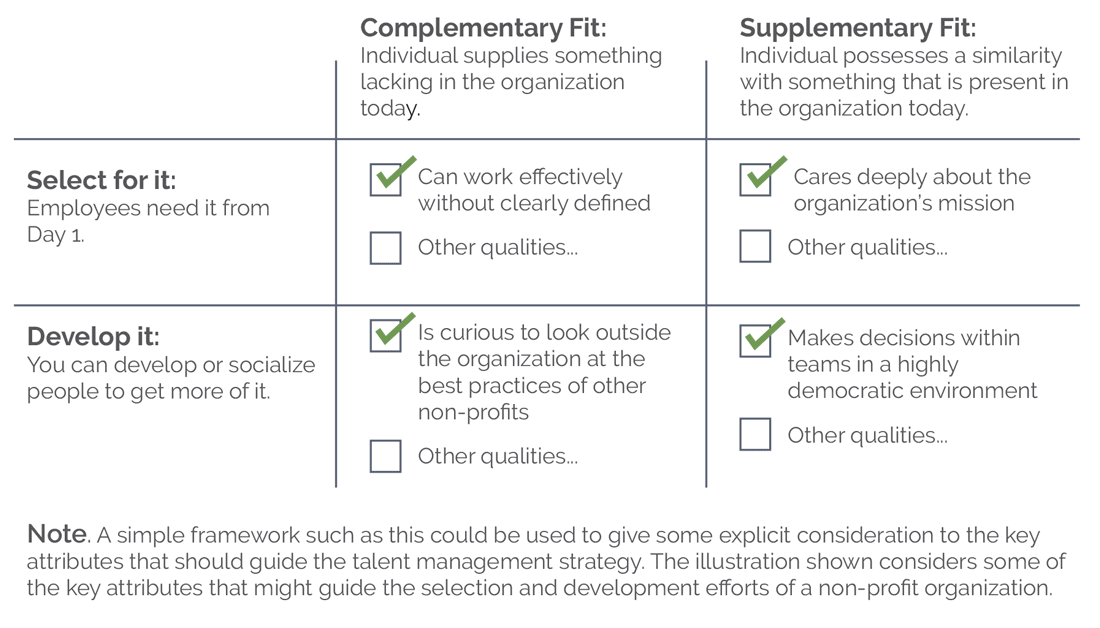
Culture Fit – a business imperative or just another form of bias?
By Bryan Adkins Ed.D., CEO, Denison Consulting
Culture Fit…The fit between an individual and the organization they work for.
Culture fit has been a topic of interest for a number of years. When I started my own dissertation research in 1997, I focused on Person-Organization (P-O) Fit as measured by Value Congruence between employees and their employer. It is a topic that gained much traction in the 1980’s as the study of organizational culture gathered steam and the subject matter became better understood. Although the topic is not new, recently it has received some interesting publicity.
The question being raised is whether hiring for culture fit and assessing fit as part of an individual’s ‘performance’ is a legitimate qualification for hiring and continued employment, or is it a vague and ambiguous excuse used to legitimize bias towards people who look, think, and act differently. I would argue that it is a business imperative AND has the potential to be used as an unjust form of bias. Let me elaborate.
The case for culture fit as a business imperative will not be surprising to many who are familiar with the evidence linking culture to business performance. No one questions that an employee or contract worker must possess basic skills required to do a job. We would argue that the ability to do a job is not a form of bias but rather a necessity to getting work done. You can think of this as the ‘what’ of the work. However, few of us are workers on an island with little or no need for interaction with others. Thus ‘how’ work gets done as we engage with others is also important.
The combination of ‘what’ the work is and ‘how’ it gets done represents a symbiotic relationship. Would an organization be expected to hire or retain an employee who gets the work done – the ‘what’ – even if they create resentment and frustration for those around them due to ‘how’ they get the work done? If other valued talent leaves the organization, do you look the other way and say ‘well, at least the job was completed’? Of course not.
When leading an organization, you have a responsibility for how the system works together and an obligation to attract and align people around a common vision and set of values to increase your likelihood for success. An employee without skill can cause as much damage as can an employee who is skilled yet constantly working against the system. It is important to note that sometimes the system needs someone to challenge and change it – thus the question of fit is justifiably an important one to more thoroughly understand.
It is essential to recognize that the term ‘fit’ can mean different things to different people. While some may think about bias or even prejudice when they hear the term fit, others think about what is appropriate or acceptable. The research often differentiates between supplementary and complementary fit, where supplementary fit is when an individual brings characteristics that are already present to a group or organization, while complementary fit is when an individual brings something that is new to the group. These are important distinctions. Without that differentiation, the term ‘fit’ can be a legitimate cause for concern. As Fortune pointed out in a recent article, if ‘culture fit’ is used to rationalize not hiring someone who is different because of race, gender, class, sexual orientation, or education – this is not only unfair, it may be illegal.
Facebook is an example of an organization that does not use the word ‘fit’, as they equate the word with bias. Instead they emphasize selecting people who are ‘additive’ to the culture and yet will embrace and demonstrate the organization’s values on a daily basis. I would argue that what they are looking for is both supplementary AND complementary fit, though as noted they discourage the use of the word ‘fit’.v
They are explicitly and unapologetically encouraging the attraction and retention of employees who will exemplify the company’s core values (supplementary fit) while encouraging those employees to also bring to the job what makes them ‘unique’ (complementary fit).
 As I learned in my early research, Values are one of the areas where emphasis on supplementary fit seems appropriate, assuming that you have clear, practiced values in the organization today. If you value decisiveness, speed, agility and action, someone who is more deliberate, contemplative and slow to act will feel like a fish out of water and it will be obvious to everyone. In that respect, having a well-established culture can help reduce recruitment costs and the risk of investing too much time and energy in an individual who truly is not a good fit. However, if the organization that relies on speed, agility and action finds that those behaviors are creating unanticipated problems and wants to make a conscious choice to shift or moderate that behavior, seeking out people who will complement the culture may make sense. Knowing what you have and what you need is fundamental to making intentional decisions about fit.
As I learned in my early research, Values are one of the areas where emphasis on supplementary fit seems appropriate, assuming that you have clear, practiced values in the organization today. If you value decisiveness, speed, agility and action, someone who is more deliberate, contemplative and slow to act will feel like a fish out of water and it will be obvious to everyone. In that respect, having a well-established culture can help reduce recruitment costs and the risk of investing too much time and energy in an individual who truly is not a good fit. However, if the organization that relies on speed, agility and action finds that those behaviors are creating unanticipated problems and wants to make a conscious choice to shift or moderate that behavior, seeking out people who will complement the culture may make sense. Knowing what you have and what you need is fundamental to making intentional decisions about fit.
Another important aspect of this discussion is the focus on recruitment and selection. Culture is a complex set of habits, norms, values and practices that develop over time. It would be impossible to only recruit people who come into an organization understanding how things are done, where we can simply ‘plug and play’. Even supplementary fit is not instantaneous and must be developed over time.
Below is a framework/tool that could help an organization to be strategic and intentional when it comes to culture fit.

Organizations can determine what goes in each box and such determinations can also be informed by research. For example, one could argue that the most important things to go in “Select for It” are the things that research shows to be fairly stable across an adult life span, such as personality/disposition and cognitive ability. On the other hand, when it comes to something like skills, competencies, and mindsets, those things can be shaped and the organization could take a position that they can be developed.
Knowing when and how to determine the appropriate fit for an organization can be challenging. There are several things that we would encourage you to think about:

 Understand your current culture.
Understand your current culture.
Do you know how clear and aligned your people are today in critical areas such as your Mission, Values, Strategy and Customer Focus? It is impossible to determine whether someone is a potential fit if you can’t describe what it is that they are expected to fit into. The more ambiguous your culture is, the more risk there is that fit will take the form of personal bias and that you will be hiring people that are simply ‘cut from the same cloth’ as the hiring manager.
When making hiring decisions and assessing performance, be clear about the cultural characteristics that are non-negotiable and require an emphasis on supplementary fit. These may include things such as the Core Values and support for the Mission and Strategy of the organization. As noted earlier, even the non-negotiables will require clarification, socialization and reinforcement. Also be deliberate in assessing gaps in the way the organization operates today and actively seek out and recognize employees who challenge current practices and compliment (bring something new to) existing ways of working.
 Use proven methods for managing culture and fit.
Use proven methods for managing culture and fit.
Understanding the interaction between culture and employee requires a three-fold evaluation:
• Assessing the organization’s strengths, weaknesses, and goals.
• Assessing the employee’s strengths, weaknesses, and goals.
• Mapping the matches and mismatches between the two.
Ultimately it is less about whether you use the word ‘fit’ to consciously develop your culture and to assess talent, rather it is about your ability to clarify key cultural boundaries driven by your values and a shared vision of where you want the organization to go. Within those boundaries you may choose to intentionally supplement the culture by selecting and recognizing individuals who live the values and work to make the vision a reality while creating the space for employees to compliment the organization through their unique experiences, passions and talent.
Bryan Adkins, Ed.D.
Connect with Insights from Denison
If you’d like to be kept up to date when we release a new TRANSFORM article or important piece of research, we can notify you so you have immediate access. Yes, please let me know.


